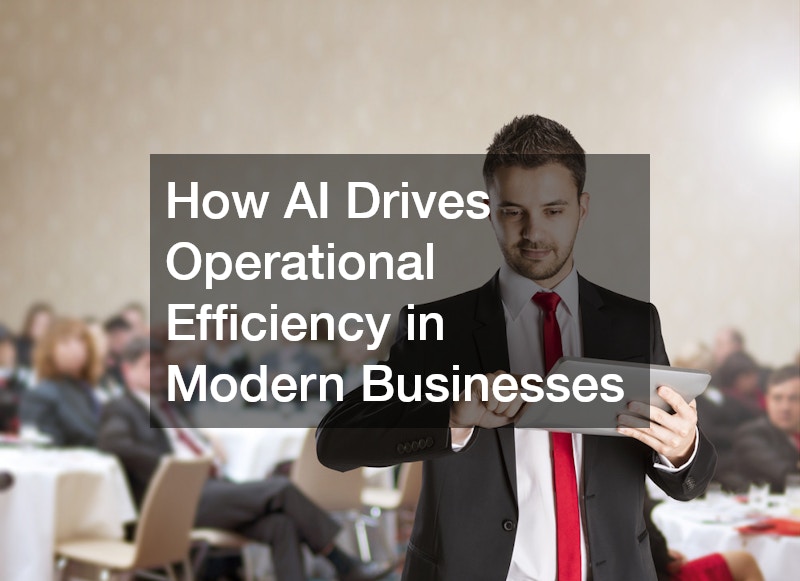Introduction
In today’s rapidly evolving business landscape, operational efficiency has become paramount. Companies are increasingly turning to AI technologies to streamline processes and boost productivity, making operational efficiency metrics more favorable. This article delves into the pivotal role that AI plays in driving operational efficiency, ultimately fostering business growth and innovation.
Understanding AI’s Role in Business Operations
What Is AI in Business Operations?
AI, or Artificial Intelligence, refers to the simulation of human intelligence in machines designed to perform tasks that typically require human intervention. In business operations, AI is employed to optimize processes like data analysis, customer service, and administrative tasks. AI tools such as chatbots, machine learning algorithms, and business intelligence software are commonly used to enhance operational efficiency.
Businesses utilize AI to manage large volumes of data, automate mundane tasks, and gain insights into complex problems. By integrating AI, companies can refine their operations, reduce costs, and allocate resources more effectively. For example, predictive analytics can anticipate market trends and customer behavior, enabling more informed decision-making.
AI tools are now integral in various sectors, from finance to healthcare, and have revolutionized the way businesses operate. As AI technology advances, its applications in business processes continue to grow, paving the way for more innovative solutions. As a result, understanding AI’s role in business operations is crucial for leveraging its full potential.
How AI Enhances Operational Efficiency
One of the primary ways AI enhances operational efficiency is by automating repetitive and time-consuming tasks. This not only frees up human resources for more strategic work but also minimizes human error. Additionally, AI’s ability to analyze large data sets in real-time allows businesses to make swift and accurate decisions.
AI-driven analytics provide deep insights into operational processes, identifying inefficiencies and areas for improvement. By continuously learning and adapting, AI systems can optimize workflows, leading to streamlined operations. For instance, machine learning algorithms can predict inventory needs, reducing both surplus and shortages.
AI also improves decision-making by providing data-driven insights, reducing the reliance on gut feeling or guesswork. This heightened level of precision enhances overall productivity, making operations more fluid and responsive. Ultimately, AI fosters a more agile and efficient business environment.
The Impact of AI on Business Growth
AI acts as a catalyst for business scalability and innovation by enabling companies to handle increased operational demands efficiently. Through automation and process optimization, businesses can scale their operations without proportionately increasing their workforce or resources. This scalability is crucial for maintaining competitive advantage in dynamic markets.
Case studies abound of companies leveraging AI to drive significant growth. For example, Amazon uses AI for demand forecasting and inventory management, which has streamlined its supply chain and reduced operational costs. Similarly, Netflix employs AI algorithms to personalize content recommendations, enhancing user engagement and subscription rates.
AI-driven innovation also opens up new business opportunities. By analyzing market trends and consumer behavior, AI can identify gaps and potential areas for expansion. Consequently, businesses that invest in AI technologies often see substantial returns in growth and market share, reinforcing the importance of integrating AI for operational efficiency.
Key Areas Where AI Drives Operational Efficiency
Automation and Task Management

Automation is one of the most significant contributions of AI to operational efficiency. Businesses can automate administrative tasks, customer service interactions, and routine operations, thus saving time and reducing errors. For instance, AI-powered chatbots can handle customer queries, freeing up human agents for more complex issues.
AI-driven task management platforms allow for more efficient project handling and resource allocation. These platforms can prioritize tasks, set deadlines, and provide real-time updates, ensuring projects stay on track. Such automation reduces the administrative burden on employees, allowing them to focus on their core responsibilities.
Businesses across various sectors have successfully implemented AI tools to enhance operational efficiency. For example, companies like UiPath offer robotic process automation (RPA) solutions that automate repetitive back-office tasks. These advancements underscore the transformative impact of AI in improving task management and overall efficiency.
Process Optimization with Machine Learning
Machine learning algorithms are pivotal in analyzing vast amounts of data to optimize complex processes. By identifying patterns and insights from data, machine learning can suggest improvements that enhance efficiency. For example, in telecommunications, machine learning can optimize network performance by predicting usage patterns and adjusting resources accordingly.
Continuous learning systems allow machine learning models to adapt to new data and changing conditions. This real-time adjustment ensures that operations are consistently optimized for the best performance. As a result, businesses can respond more effectively to market dynamics and operational challenges.
By implementing machine learning, companies can achieve significant process improvements. For instance, logistics companies use machine learning for route optimization, reducing fuel consumption and delivery times. Such examples highlight the substantial benefits of machine learning in process optimization, driving operational efficiency across industries.
AI in Supply Chain Management
AI-powered supply chain management is revolutionizing the way businesses handle logistics and inventory. Advanced algorithms predict demand, manage inventory levels, and optimize logistics operations, reducing delays and enhancing productivity. For instance, AI systems can analyze historical sales data to forecast demand more accurately, minimizing stockouts and overstock.
Inventory management is another critical area where AI drives efficiency. AI tools can automate inventory tracking, ensuring optimal stock levels and timely reordering. By reducing manual intervention, AI reduces errors and ensures a more streamlined supply chain process.
Logistics operations benefit significantly from AI-driven automation. AI can plan optimal delivery routes, monitor shipments in real-time, and predict potential disruptions. Companies like DHL are leveraging AI solutions to enhance their supply chain operations, ensuring timely deliveries and improved customer satisfaction.
Predictive Maintenance in Manufacturing

AI-driven predictive maintenance is a game-changer in the manufacturing sector, significantly reducing downtime and increasing equipment lifespan. Predictive maintenance uses AI algorithms to analyze data from sensors and machinery to predict potential failures before they occur. This proactive approach to maintenance minimizes production interruptions.
By employing AI sensors, manufacturers can continuously monitor equipment conditions and performance. When anomalies are detected, the system can trigger alerts for scheduled maintenance, preventing costly breakdowns. Companies such as GE and Siemens have successfully implemented AI-driven predictive maintenance to enhance their operational efficiency.
AI also optimizes maintenance schedules by prioritizing critical equipment, ensuring that resources are allocated efficiently. This targeted approach reduces unnecessary maintenance activities and maximizes equipment uptime. Consequently, predictive maintenance through AI leads to significant cost savings and operational improvements in manufacturing.
AI and Data-Driven Decision Making
Leveraging AI for Real-Time Analytics
Real-time analytics powered by AI enable businesses to make quick and informed decisions across various departments. By processing vast amounts of data in real-time, AI tools provide actionable insights that drive operational efficiency. For instance, AI can analyze customer behavior data to optimize marketing campaigns on the fly.
AI tools such as IBM Watson and Google Analytics are instrumental in providing real-time analytics. These tools aggregate data from multiple sources, presenting it in user-friendly dashboards for easy interpretation. This instant access to data allows businesses to respond swiftly to market trends and operational challenges.
Real-time analytics also play a crucial role in detecting and mitigating risks. Companies can monitor financial transactions in real-time to identify fraudulent activities and take immediate action. This capability not only enhances operational efficiency but also protects businesses from potential losses.
Business Intelligence and AI
AI-powered business intelligence tools are revolutionizing the way companies derive actionable insights from data. These tools collect, process, and analyze data, providing businesses with valuable insights that inform strategic decisions. For example, AI algorithms can identify market trends, customer preferences, and operational inefficiencies.
Businesses across various sectors are leveraging AI for operational efficiency. In retail, AI tools analyze sales data to refine inventory management and pricing strategies. In healthcare, AI aids in patient management and diagnostics, enhancing patient outcomes and reducing costs.
Case studies demonstrate the effectiveness of AI-generated insights in refining business operations. Companies like Coca-Cola have implemented AI-driven business intelligence tools to optimize their supply chain and marketing strategies. These success stories underscore the transformative potential of AI in driving operational efficiency and business growth.
AI in Customer Service and Experience
AI Chatbots and Virtual Assistants
AI chatbots and virtual assistants have become essential tools for enhancing customer service and experience. These AI-driven solutions handle customer queries efficiently, providing instant responses and solutions. For example, companies like Sephora use AI chatbots to assist customers with product recommendations and inquiries.
The use of AI chatbots significantly reduces response times, leading to higher customer satisfaction. Customers no longer need to wait for human agents, and routine inquiries are resolved swiftly. This improvement in service efficiency can lead to increased customer loyalty and retention.
Moreover, AI chatbots are capable of handling multiple customer interactions simultaneously, ensuring no query goes unanswered. This scalability is particularly beneficial during peak times or promotional events. As a result, AI chatbots and virtual assistants are instrumental in delivering seamless and efficient customer service.
AI in Personalizing Customer Experience
Personalized customer experiences are crucial for engaging and retaining customers, and AI plays a significant role in achieving this. AI algorithms analyze customer data to provide personalized recommendations and content. For instance, e-commerce platforms like Amazon use AI to suggest products based on browsing history and purchase behavior.
This personalized approach increases customer engagement and boosts sales. Customers are more likely to purchase products that are relevant to their interests and needs. AI-driven personalization also enhances the overall user experience, making interactions more meaningful and enjoyable.
Businesses across various sectors are adopting AI to personalize customer experiences. Streaming services like Netflix use AI to recommend content, resulting in higher viewer retention. These examples highlight the effectiveness of AI in personalizing customer interactions, leading to improved satisfaction and business growth.
Overcoming Challenges in Implementing AI for Operational Efficiency
Common Hurdles Businesses Face
Although AI offers significant benefits, businesses often face challenges in its implementation. A lack of technical expertise is a common hurdle, as successful AI adoption requires skilled professionals. Additionally, data privacy and security concerns can hinder AI integration, particularly in sectors dealing with sensitive information.
Integration with existing systems is another challenge. Many businesses operate on legacy systems that may not be compatible with AI technologies. This incompatibility can lead to additional costs and effort in upgrading or replacing outdated infrastructure.
Despite these challenges, businesses must recognize the long-term benefits of AI for operational efficiency. Addressing these hurdles through strategic planning and investment in resources is essential for successful AI adoption. By overcoming these obstacles, companies can unlock the full potential of AI-driven efficiencies.
Actionable Steps to Implement AI Effectively
To implement AI effectively, businesses should invest in AI training for their teams. This training equips employees with the necessary skills to leverage AI tools and technologies. Additionally, starting small with pilot AI projects allows companies to assess the feasibility and impact of AI before scaling up.
Collaborating with AI consultants can also facilitate smooth integration. These consultants bring expertise and experience in implementing AI solutions tailored to specific business needs. Their insights help businesses avoid common pitfalls and achieve successful AI integration.
Moreover, businesses should continuously evaluate and update their AI strategies. As AI technologies evolve, staying current with advancements ensures that businesses remain competitive. By adopting a proactive approach, companies can maximize the benefits of AI for operational efficiency.
Future-Proofing Your Business with AI
Future-proofing a business with AI involves continuously evolving AI strategies to stay ahead of the competition. This requires ongoing investment in AI research and development to adapt to new trends and technologies. For instance, businesses should explore emerging AI applications like edge computing and AI-driven cybersecurity.
Maintaining a flexible AI strategy allows businesses to pivot quickly in response to market changes. This agility is crucial for sustaining operational efficiency and competitiveness. Implementing AI in a phased manner, starting with critical areas and expanding gradually, ensures effective resource allocation.
Ultimately, businesses that embrace AI for operational efficiency are better positioned for long-term success. By leveraging AI’s transformative potential, companies can enhance productivity, reduce costs, and drive innovation. Future-proofing with AI is not just an option but a necessity for businesses aiming to thrive in a competitive landscape.
Real-World Examples of AI-Driven Operational Efficiency
AI Success Stories in Various Industries
Several industries have successfully implemented AI to enhance operational efficiency. In retail, companies like Walmart use AI for inventory management, optimizing stock levels and reducing wastage. AI algorithms analyze sales data to forecast demand accurately, ensuring the right products are available at the right time.
The healthcare sector also benefits from AI-driven efficiencies. AI tools assist in patient management by automating administrative tasks and providing diagnostic support. For example, IBM Watson Health uses AI to analyze medical data, offering insights that improve patient outcomes and streamline operations.
In manufacturing, AI-driven predictive maintenance ensures equipment remains operational with minimal downtime. Companies like General Electric employ AI sensors and predictive algorithms to monitor machinery, scheduling maintenance proactively. These success stories demonstrate the transformative impact of AI across various industries, driving operational efficiency and growth.
Lessons Learned from AI-Driven Efficiency
Businesses that have successfully integrated AI offer valuable lessons for others looking to enhance operational efficiency. One key takeaway is the importance of starting small with pilot projects. This allows businesses to understand AI’s capabilities and limitations before full-scale implementation.
Another lesson is the need for cross-functional collaboration. Involving various departments ensures a holistic approach to AI integration, addressing different aspects of operational efficiency. For example, collaboration between IT and operations teams can streamline the deployment and management of AI solutions.
Finally, continuous learning and adaptation are crucial for maximizing AI’s benefits. Businesses should regularly update their AI strategies and stay informed about technological advancements. By learning from these best practices, companies can successfully harness AI for operational efficiency, driving sustained growth and innovation.
Conclusion
AI is undeniably transforming the way businesses operate, driving significant improvements in operational efficiency. From automating routine tasks to optimizing complex processes, AI’s applications are vast and impactful. By leveraging AI for real-time analytics and data-driven decision-making, companies can achieve greater productivity and scalability.
As businesses face challenges in AI implementation, adopting a strategic approach and investing in resources are essential. Collaborating with AI consultants and continuously evolving AI strategies ensure successful integration. Companies that embrace AI-driven solutions are better equipped to stay competitive in a dynamic market landscape.
In summary, AI plays a pivotal role in enhancing operational efficiency across various business areas. Companies are encouraged to explore AI-driven solutions for boosting their operational efficiency and achieving long-term success. For more insights on optimizing your operations, refer to our operational efficiency metrics pillar content.
